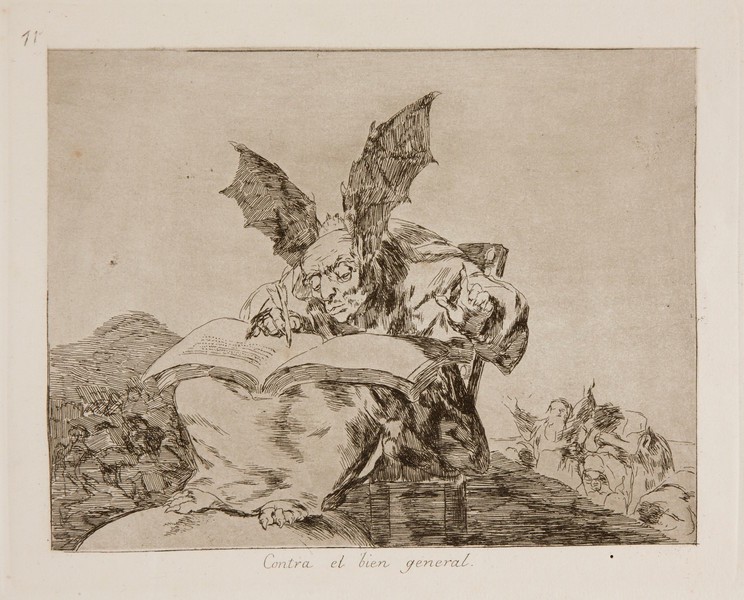- Cronología
- Ca. 1820 - 1823
- Dimensiones
- 177 x 221 mm
- Técnica y soporte
- Etching and burnisher
- Reconocimiento de la autoría de Goya
- Undisputed work
- Ficha: realización/revisión
- 03 Jan 2011 / 02 Jun 2023
- Inventario
- 225
See Sad forebodings of what is to come.
The title of the print was handwritten by Goya on the first and only series known to us at the time of its production, which the painter gave to his friend Agustín Ceán Bermúdez. Thus the title was subsequently engraved on the plate without any modification from Ceán Bermúdez's copy for the first edition of the Disasters of War published by the Royal Academy of Fine Arts of San Fernando in Madrid in 1863.
A preparatory drawing of this engraving is in the Prado Museum
A scribe, possibly an ecclesiastical figure, with bat-like wings, ears, hands and feet with long nails that could symbolise greed, sits writing. His feet are resting on the top of a sphere, and in the background of the engraving a group of people can be seen with gestures that speak of their despair.
This is one of the most complex and hermetic of the emphatic Caprices, perhaps because of the harshness of its critical content. Various interpretations have been proposed for it, although for the most part specialists seem to agree that it is a scribe who applies himself to the drafting of laws that are "against the general good".
Nigel Glendinning emphasises the presence in this engraving of vampire wings on the scribe instead of ears, and believes that this figure may have been taken from the work Gli animali parlanti (1801) by Giambattista Casti (Viterbo or Acquapendente, 1724-Paris, 1803). In this text the vampire chief heads a group of greedy notaries, criminals and economists who, in time, will become the crown's advisor.
For her part, Jesusa Vega believes that this print represents the moment of crisis prior to Ferdinand VII's return to the throne, when the struggle between the servile and liberal factions took place.
It is possible that this print is related to the next one, no. 72, The Results. It repeats the allusion to the vampire who is sucking the chest of a lying figure, perhaps a corpse. It is probable, therefore, that the circumstance described in engraving no. 72 is the result of the measures taken in no. 71.
The plate is in the National Chalcography (cat. 322).
-
Goya. Das Zeitalter der Revolucionen. Kunst um 1800 (1980 – 1981)Hamburger KunsthalleHamburg1980cat. 10
-
Francisco de GoyaMuseo d'Arte ModernaLugano1996exhibition celebrated from September 22nd to November 17th.cat. 71
-
Francisco de Goya: Maleri, Tegning, GrafikkNasjonalgallerietOslo1996from 10th to April 14th 1996cat. 153
-
Francisco Goya. Sein leben im spiegel der graphik. Fuendetodos 1746-1828 Bordeaux. 1746-1996Galerie KornfeldBern1996from November 21st 1996 to January 1997cat. 161
-
Francisco Goya. Capricci, follie e disastri della guerraSan Donato Milanese2000Opere grafiche della Fondazione Antonio Mazzottacat. 151
-
Goya: Prophet der ModerneAlte NationalgalerieBerlin2005from July 13th to October 3th 2005. Exhibitied also at the Kunsthistorischemuseum, Vienna, October 18th 2005 to January 8th 2006, consultant editor Manuela B. Mena Marquéscat. 123
-
Goya en tiempos de guerraMuseo Nacional del PradoMadrid2008consultant editor Manuela B. Mena Marqués, from April 14th to July 13th 2008cat. 115
-
Goya et la modernitéPinacothèque de ParisParís2013from October 11st 2013 to March 16th 2014cat. 110
-
Goya, grabadorMadridBlass S.A.1918cat. 173
-
Goya engravings and lithographs, vol. I y II.OxfordBruno Cassirer1964cat. 191
-
Vie et ouvre de Francisco de GoyaParísOffice du livre1970cat. 1116
-
A solution to the enigma of Goya’s emphatic caprices nº 65-80 of The Disasters of WarApollo1978pp.186-191
-
Catálogo de las estampas de Goya en la Biblioteca NacionalMadridMinisterio de Educación y Cultura, Biblioteca Nacional1996cat. 290
-
El Libro de los Desastres de la GuerraMadridMuseo del Prado2000pp.139-141
-
ParísPinacoteca de París2013p. 155
-
Goya. In the Norton Simon MuseumPasadenaNorton Simon Museum2016pp. 114-151

